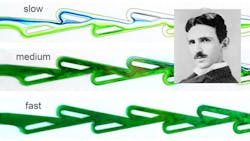The Tesla Valve: Bringing Back a Forgotten Invention
Scientists have dusted off the mechanics behind a 100-year-old valve and are reimagining it for use in current and future technology.
The device, originally known as a “valvular conduit,” was invented by Nikola Tesla, who was awarded a patent for the invention on Feb. 3, 1920.
Scientists at New York University’s Courant Institute of Mathematical Sciences have re-engineered replicas of the one-way valve and report that the device is more functional than was previously realized. According to their findings reported in the journal Nature Communications, the Tesla Valve could harness the vibrations in engines and other machinery to pump fuel, coolants, lubricants and other gases and liquids.
“While Tesla is known as a wizard of electric currents and electrical circuits, his lesser-known work to control flows or fluid currents was truly ahead of its time,” said Leif Ristroph, an associate professor and the paper’s senior author.
The re-engineered Tesla Valve has no moving parts, consisting instead of a series of “interconnected teardrop-shaped loops” which allow fluid to pass through in one direction.
The device provides a clear path for forward flows, but the route is slower for reverse flows, noted the researchers. The slower reverse flow is an unrealized benefit in circumstances when flows need to be controlled rather than unleashed, they added.
In lab tests, the researchers measured the valve’s resistance to passing flow in the two directions. They found:
- At low flow rates there is no difference in resistance for forward and reverse flows.
- Above a certain flow speed, the device abruptly “turns on” and significantly checks or resists reverse flows.
“Crucially, this turn-on comes with the generation of turbulent flows in the reverse direction, which ‘plug’ the pipe with vortices and disrupting currents,” explained Ristroph. “Moreover, the turbulence appears at far lower flow rates than have ever previously been observed for pipes of more standard shapes—up to 20 times lower speed than conventional turbulence in a cylindrical pipe or tube. This shows the power it has to control flows, which could be used in many applications.”
The researchers said that the valve works better when the flow is not steady; when the flow comes in pulses or oscillations, the device converts into smooth and directed output flow. This pumping action mimics the AC-DC converters that transform alternating current to direct current, they explained.
The Tesla device can be viewed as an alternative to the conventional check valve, noted Ristroph. The valve’s ability to control flows and generate turbulence at low speeds expands the possibilities for Tesla’s invention, he said.
According to Ristroph, the device is very effective at mixing. “[It] could be used to harness the vibrations in engines and machinery to pump fuel, coolant, lubricant or other gases and liquids,” he said.
About the Author

Rehana Begg
Editor-in-Chief, Machine Design
As Machine Design’s content lead, Rehana Begg is tasked with elevating the voice of the design and multi-disciplinary engineer in the face of digital transformation and engineering innovation. Begg has more than 24 years of editorial experience and has spent the past decade in the trenches of industrial manufacturing, focusing on new technologies, manufacturing innovation and business. Her B2B career has taken her from corporate boardrooms to plant floors and underground mining stopes, covering everything from automation & IIoT, robotics, mechanical design and additive manufacturing to plant operations, maintenance, reliability and continuous improvement. Begg holds an MBA, a Master of Journalism degree, and a BA (Hons.) in Political Science. She is committed to lifelong learning and feeds her passion for innovation in publishing, transparent science and clear communication by attending relevant conferences and seminars/workshops.
Follow Rehana Begg via the following social media handles:
X: @rehanabegg
LinkedIn: @rehanabegg and @MachineDesign

